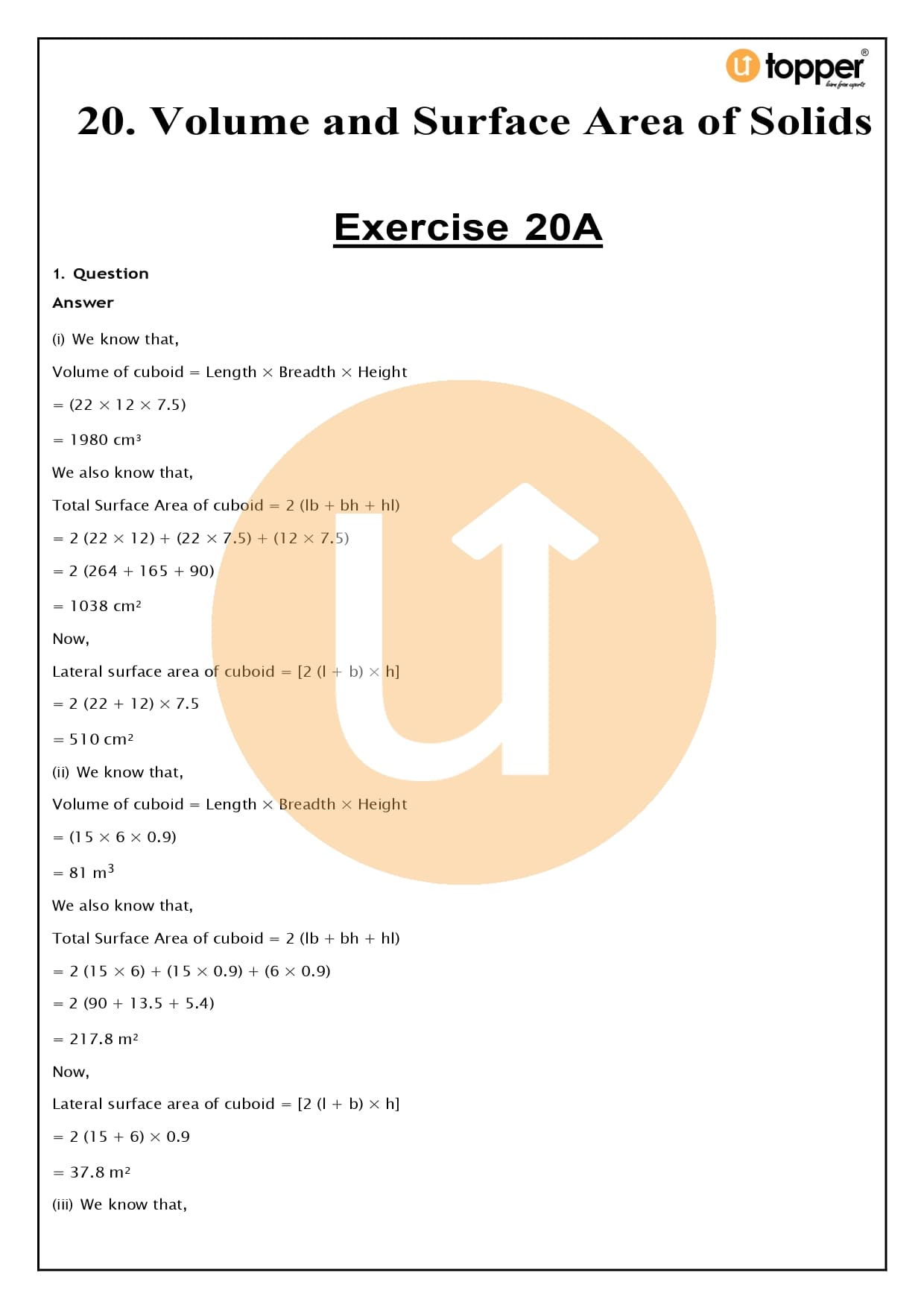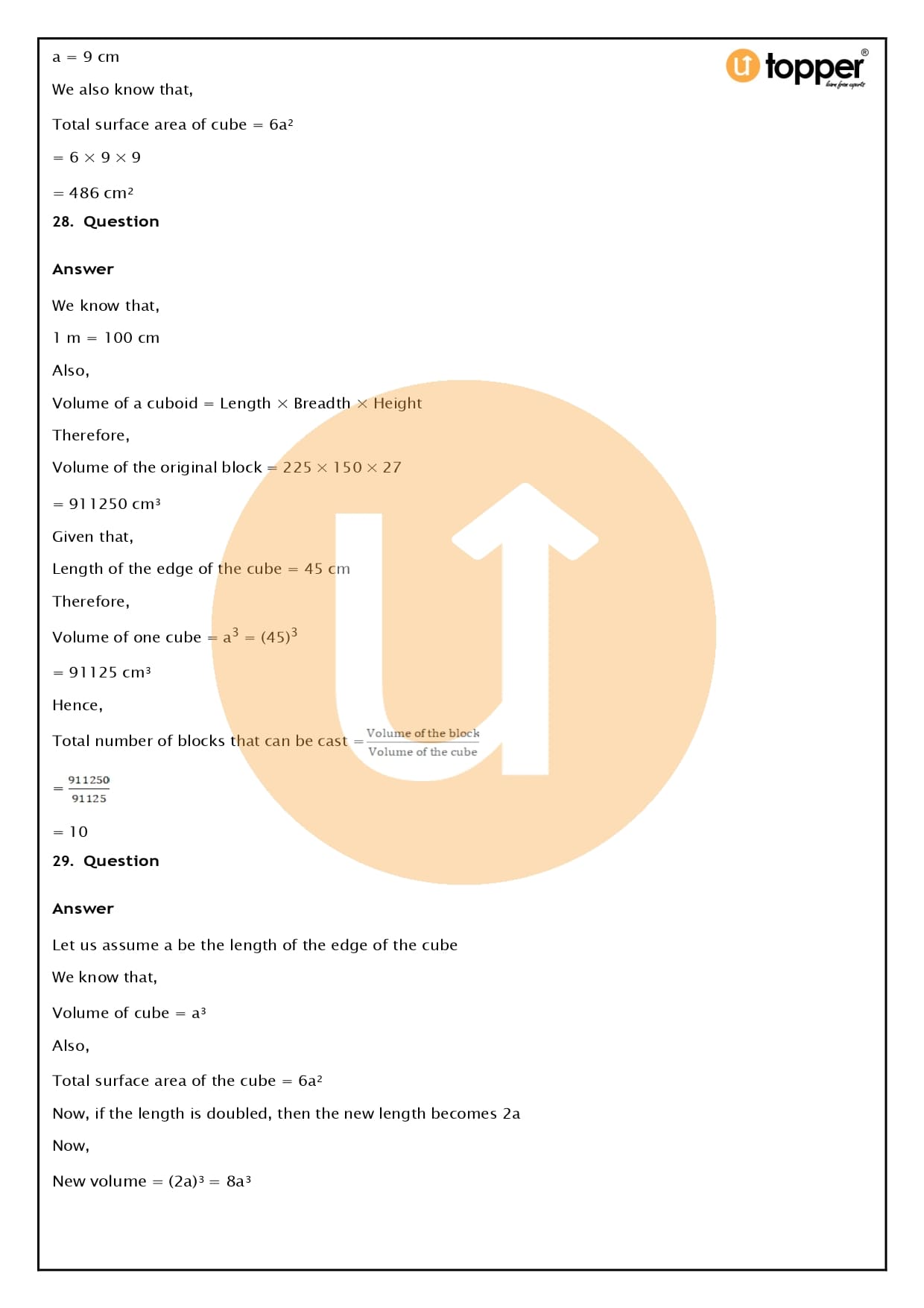RS Aggarwal Class 8 Solutions Chapter 20
RS Aggarwal Solutions for Class 8 Chapter 20 – Volume and Surface Area of Solids PDF
RS Aggarwal Class 8 Maths Solutions Chapter-wise – Free PDF Download
Find out how to figure out the volume and surface area of solids with RS Aggarwal Class 8 Solutions Chapter 20 put together by Utopper’s subject matter experts. RS Aggarwal Class 8 Solutions Chapter 20 Solutions is a must-have for students who want to do well on their math exams. It has clear explanations and a diagrammatic approach to all the problems. Scholars at Utopper spent a lot of time and effort on these RS Aggarwal Solutions for Class 8 Chapter 20.
They are meant to help students in class 8. All of the questions are answered correctly in the solutions, so reading the RS Aggarwal Solutions for Class 8 Chapter 20 will give you more confidence in this subject.
Utopper is a website where students can get free Reference Book Solutions and other study materials like Revision notes, Sample papers, and Important Question class 8. Science and Maths will be easier to learn if you have access to RS Aggarwal Solutions for Class 8 and solutions for other courses.
Click Here – To Buy/Purchase RS Aggarwal Class 8 Solutions Online
RS Aggarwal Class 8 Solutions Chapter 20 – Volume and Surface Area of Solids





















































RS Aggarwal Class 8 Solutions
Chapter-1 Rational Numbers
Chapter-2 Exponents
Chapter-3 Squares and Square Roots
Chapter-4 Cubes and Cube Roots
Chapter-5 Playing with Numbers
Chapter-6 Operations on Algebraic Expressions
Chapter-7 Factorisation
Chapter-8 Linear Equations
Chapter-9 Percentage
Chapter-10 Profit and Loss
Chapter-11 Compound Interest
Chapter-12 Direct and Inverse Proportions
Chapter-13 Time and Work
Chapter-14 Polygons
Chapter-15 Quadrilaterals
Chapter-16 Parallelograms
Chapter-17 Construction of Quadrilaterals
Chapter-18 Area of a Trapezium and a Polygon
Chapter-19 Three-Dimensional Figures
Chapter-20 Volume and Surface Area of Solids
Chapter-21 Data Handling
Chapter-22 Constructing and Interpreting Bar Graphs
Chapter-23 Pie Charts
Chapter-24 Probability
Chapter-25 Graphs

Download RS Aggarwal Class 8 Solutions Chapter 20 Volume and Surface Areas of Solids
Now, you can easily find the RS Aggarwal Solutions for Class 8 Chapter 20 on the Utopper website. You can also download and save these RS Aggarwal Class 8 Solutions Chapter 20 PDFs on your devices. Once you have downloaded them, you can use them to quickly review important formulas anytime, anywhere, even if you don’t have access to the internet.
Math for Grade 8: Volume and Surface Areas of Solids
In our daily lives, we come across many solids of different shapes and sizes, for which we can calculate both the surface area and the volume. We need to figure out how big things are and how much space they take up. But what if these basic shapes come together to make a new shape that isn’t the same as the original? Now, you need to figure out how to figure out the volume, area, and surface area of new objects.
When figuring out the surface area and volume of these new shapes, we have to keep the new shape in mind. Here is a detailed explanation that will help you understand these things and how to figure out how much they cost. Every day, we see many solid 3-D objects, like a book, pencil box, football, cylinder, etc. These things take up some room and have three dimensions: length, width, and height.
Some of these shapes have faces that are the same or look the same, like the bases of a cylinder, which are both circles. Here are the formulas and ways to measure the volume and surface areas of these shapes:
- The surface area of a solid is equal to the area of all of its faces or outer parts added together.
- The Volume of a Solid: This is how much space a solid shape can hold, or how big it is.
- A solid shape’s Curved Surface Area (CSA) is found by adding up the areas of all its curved surfaces.
- LSA (Lateral Surface Area) is the area around the sides, excluding the top and bottom faces.
- Depending on the shape of a solid, the LSA and CSA could be different, the same, or overlap.
- The Surface Area of a Cube: A cube has 6 square sides, so if the lengths of its sides add up to l, its surface area is 6l2.
- Surface Area of a Cuboid: If the height of a cuboid is h, its length is l, and its width is b, then the surface area of the cuboid is 2 (b * h + h * l + l * b) = 2 (bh + hl + lb).
- The Surface Area of a Cylinder: The formula for the surface area of a cylinder with a height of h and a radius of r at its circular base is 2 * r(r + h).
- The volume of a cuboid is given by l * b * h for a cuboid with height = h, length = l, and width = b.
- The Volume of a Cube: A cube is a special kind of cuboid where the length, width, and height are all the same, or h = l = b. This means that the volume of a cube is l3.
- The Volume of a Cylinder: If a cylinder is h high and its circular part has a radius of r, then its volume = * r(r + h) = r2h
- The formula for the lateral or curved surface area of a cube is 4l2, where l is the length of the cube.
- The formula for the lateral or curved surface area of a cuboid is 2h(l+b), where h is the cuboid’s height, l is its length, and b is its width.
- The formula for the lateral or curved surface area of a cylinder is 2rh, where r is the radius of the circle at the base of the cylinder and h is the height of the cylinder.
Tips for RS Aggarwal Class 8 Solutions Chapter 20
- A lot of how well you do with volume and surface area problems depends on how well you remember and use formulas. So, when you practice Class 8 Maths RS Aggarwal Chapter 20 Solution, keep a copy of all the formulas in a table form.
- Getting a good grasp on any subject requires a lot of practice, so you should go through RS Aggarwal Class 8 Chapter 20 Solutions by Utopper and focus on the problems that seem hard to you.
- Don’t avoid topics with less weight because you need to build a strong foundation in class 8 to do well in higher grades.

FAQ ( Frequently Asked Questions )
1. What’s the difference between a shape’s volume and its capacity?
Ans – Both volume and capacity are properties of any three-dimensional object.
- The volume of an object is how much space it takes up, while its capacity is how much solid, liquid, or gas it can hold.
- Cubic units are used to measure volume. On the other hand, capacity can be measured in many different ways, such as gallons, liters, pounds, etc.
- To figure out how big something is, we need to know its length, width, and height. cc or ml are used to measure capacity.
2. What happens to the volume of a solid when we turn it into a different shape?
Ans – When we change the shape of a solid by melting it or reshaping it, the solid’s volume stays the same.
3. Where can I find the notes from Class 8 Math for Volume and Surface Area of Solids?
Ans – You can find notes for the NCERT Class 8 Maths chapter “Volume and Surface Area of Solids” here on Utopper. Our academic experts put together these notes with great care. These notes go into a lot of detail about how the ideas in this chapter work. All of it is written in very simple, easy-to-understand language so that anyone can read it.
